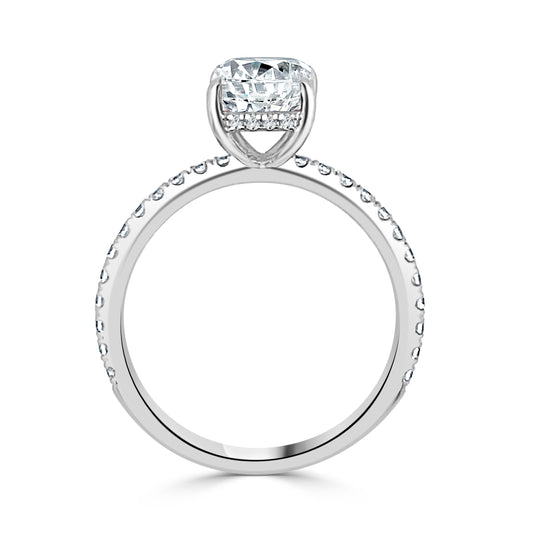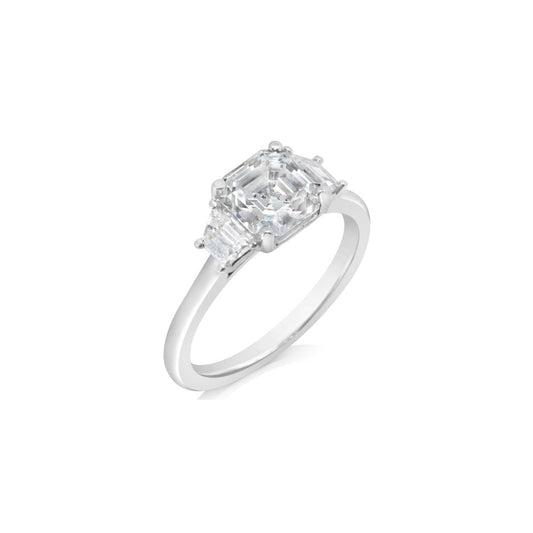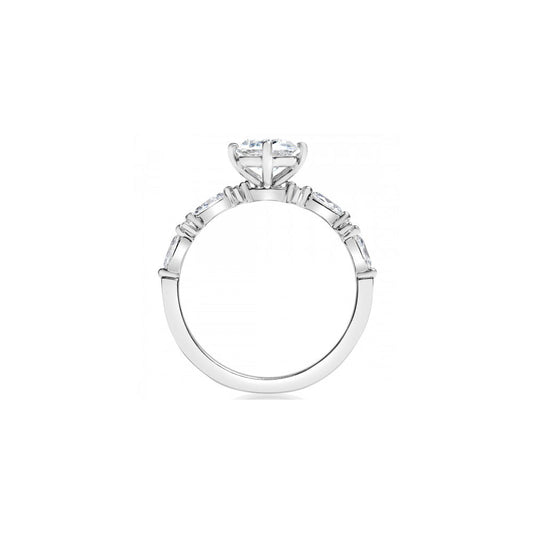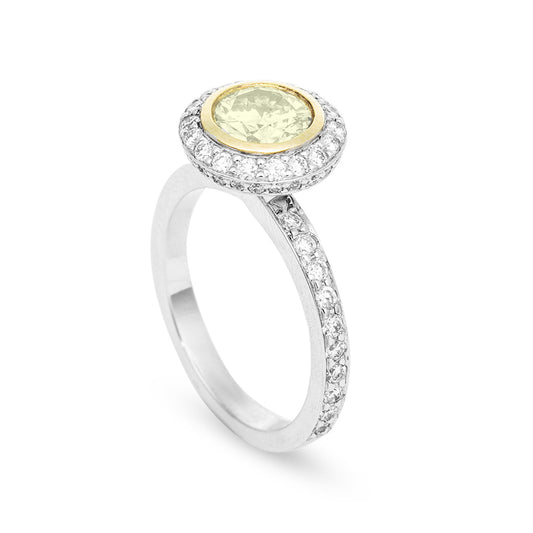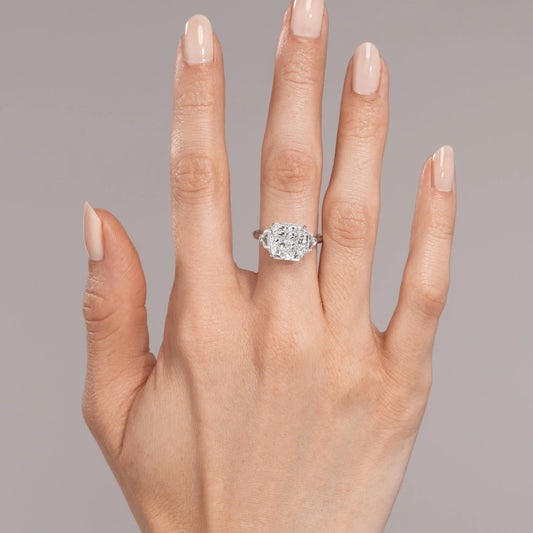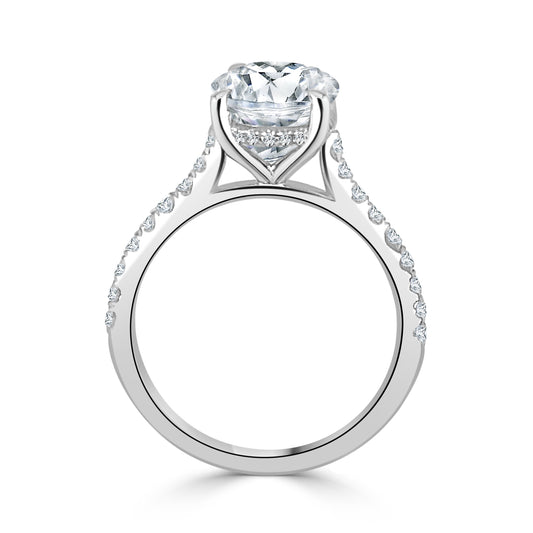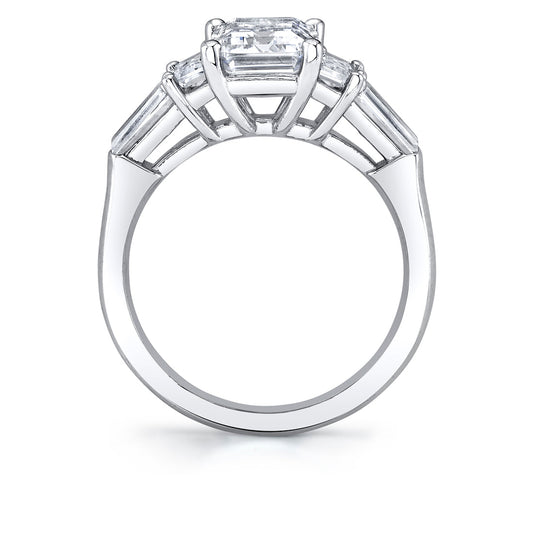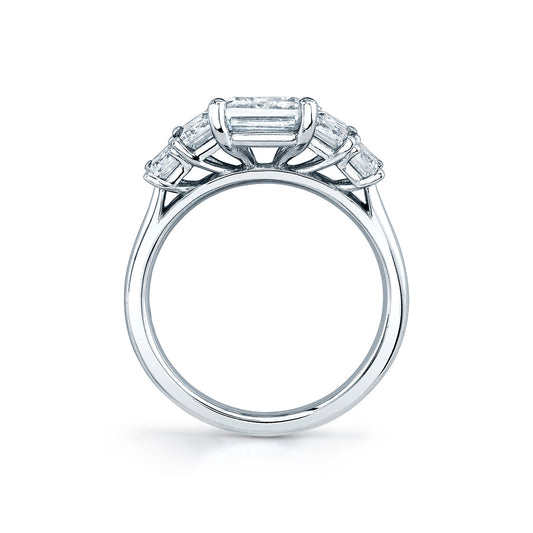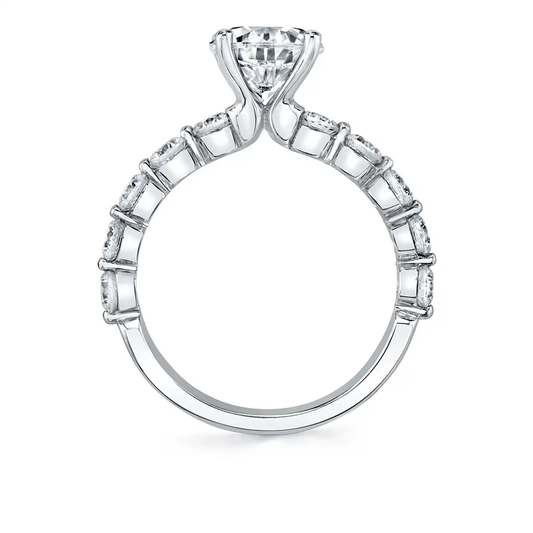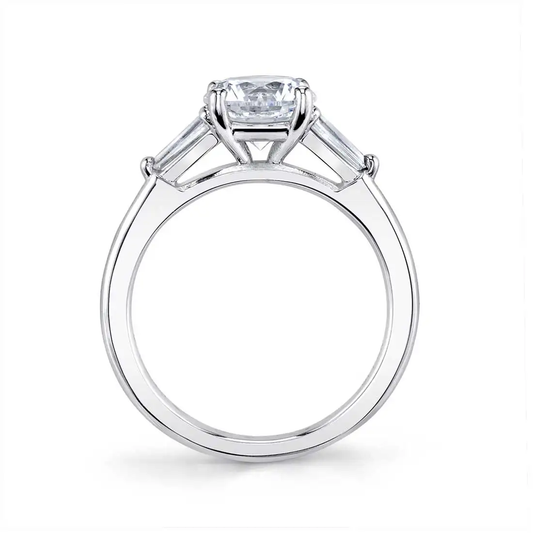Engagement Rings in Nashville, TN
Explore the largest selection of diamond engagement rings for women in Nashville, Tennessee at King Jewelers to discover a luxury shopping experience like never before. Browse loose diamonds, and a variety of trending white, yellow, and rose gold engagement ring styles, or create a custom engagement ring with one of our master jewelers!
-
Vendor:KJ5
KJ5 Diamond Round Engagement Ring Mounting 14K Yellow Gold
Regular price $1,535.00Regular price -
Vendor:KJ5
KJ5 Diamond Oval Engagement Ring Mounting 14K Yellow Gold
Regular price $1,415.00Regular price -
Vendor:KJ5
KJ5 Diamond Oval Engagement Ring Mounting 14K White Gold
Regular price $1,535.00Regular price -
Vendor:KJ5
KJ5 Diamond Emerald Cut Engagement Ring Mounting 14K Yellow Gold
Regular price $1,535.00Regular price -
Vendor:KJ5
KJ5 Diamond Emerald Cut Engagement Ring Mounting 14K White Gold
Regular price $1,535.00Regular price -
Vendor:KJ5
KJ5 Round Solitaire Hidden Diamond Halo Semi-Mount 14K White Gold
Regular price $950.00Regular price -
Vendor:KJ5
KJ5 Asscher Cut 3-Stone Engagement Ring Mounting 18K White Gold
Regular price $4,050.00Regular price -
Vendor:KJ5
KJ5 Oval 5-Stone Engagement Ring with Pear Diamonds 18K White Gold
Regular price $2,740.00Regular price -
Vendor:KJ5
KJ5 Round Semi-Mount Round and Pear Diamonds 18K White Gold
Regular price $3,040.00Regular price -
Vendor:KJ5
KJ5 Oval Ring Mounting with Marquise and Round Diamonds 18K White Gold
Regular price $2,575.00Regular price -
Vendor:KJ5
KJ5 GIA Certified Yellow Diamond Engagement Ring with Halo
Regular price $8,800.00Regular price -
Vendor:KJ5
KJ5 Hidden Halo Cushion Cut Semi-Mount 14K Yellow Gold
Regular price $1,500.00Regular price -
Vendor:KJ5
KJ5 18K White Gold Round Diamond Halo Engagement Ring Mounting
Regular price $3,322.00Regular price -
Vendor:KJ5
KJ5 18K White Gold 0.79ct Round Diamond Halo Engagement Ring Mounting
Regular price $3,675.00Regular price -
Vendor:KJ5
KJ5 Platinum EGL Certified Radiant Diamond 3-Stone Engagement Ring
Regular price $39,775.00Regular price -
Vendor:KJ5
KJ5 Round Solitaire Engagement Ring Mounting 14K White Gold
Regular price $1,035.00Regular price -
Vendor:KJ5
KJ5 0.33ct Diamond Oval Engagement Ring Mounting 18K White Gold
Regular price $2,220.00Regular price -
Vendor:Sylvie
Sylvie Bree 18K White Gold Emerald 5-Stone Engagement Ring Mounting
Regular price $10,850.00Regular price -
Vendor:Sylvie
Sylvie Dorothy 18K White Gold Round 5 Stone Engagement Ring Mounting
Regular price $10,764.00Regular price -
Vendor:Sylvie
Sylvie Brenley 18K White Gold Emerald 5-Stone Engagement Ring
Regular price $7,025.00Regular price -
Vendor:Sylvie
Sylvie Nicolette 18K White Gold Emerald 3-Stone Engagement Ring Mounting
Regular price $6,120.00Regular price -
Vendor:Sylvie
Sylvie Nicolette 18K Yellow Gold Round 3-Stone Engagement Ring Mounting
Regular price $5,760.00Regular price -
Vendor:Sylvie
Sylvie Karol 18K White Gold Round Engagement Ring Mounting
Regular price $5,200.00Regular price -
Vendor:Sylvie
Sylvie Nicolette 18K White Gold Pear 3-Stone Engagement Ring Mounting
Regular price $4,440.00Regular price

Custom Engagement Ring Design
Design an engagement ring as unique as your love at King Jewelers in Nashville, TN
Engagement Ring Info and FAQ
Engagement Ring Styles
Solitaire Engagement Rings: A plain, classic band crafted in gold or platinum, featuring a single center stone in any diamond shape of your choice.
Halo Engagement Rings: A border of smaller diamonds frame the center stone, creating a “halo” effect and giving the illusion of a bigger, more glamorous style.
Classic Engagement Rings: A single-center stone with smaller diamonds that adorn the band of the ring either all the way, halfway, or 3/4 way around.
Vintage Engagement Rings: Meticulous design, milgrain detailing, and floral accents provide an antique nostalgia to these diamond rings.
3-Stone Engagement Rings: The center diamond sits between two smaller diamonds or gemstones of any shape on either side.
Modern Engagement Rings: A contemporary twist on classic engagement ring styles, creating an alternative look that is uniquely yours.
Engagement Ring Diamond Shapes
Round Diamond: A round brilliant diamond provides the most sparkle of any diamond cut because of how the stone is faceted and reflects light. Round diamond engagement rings are also the most classic and popular shape.
Oval Diamond: An oval shape diamond is an elegant blend of the round brilliant cut and the marquise shape diamond. With almost as much brilliance as the round cut diamond, oval engagement rings portray shimmering facets and give the illusion of an elongated finger.
Princess-Cut Diamonds: Known for its geometric aesthetic, this square-shaped diamond offers style and sparkle. Utilizing more than 50 chevron-like facets, the brilliance of princess cut engagement rings is bold and sophisticated.
Emerald-Cut Diamonds: This art-deco inspired shape highlights a different type of faceting style called step cut. We admire the octagonal and rectangular nature of emerald cut engagement rings and the open table in the center, revealing the true color and clarity of the stone.
Cushion-Cut Diamonds: Sometimes referred to as the “pillow-cut diamond,” we notice rounded edges and softened corners, creating a unique blend of round brilliant and princess-cut diamond shapes.
Pear Shape Diamonds: A combination of the oval and marquise shape, we notice one end showcasing a rounded oval-like edge and the other coming to a point, much like the marquise. Pear shape engagement rings also make the finger appear longer when worn with the point facing towards the nail.
Heart-Shape Diamonds: As the most romantic symbols of love, heart-shaped engagement rings feature a precise length-to-width ratio to provide balanced curves and symmetry. Heart shape diamonds are perfect for classic romantics.
Marquise Diamond: This shape can maximize the carat weight of your diamond, appearing much larger than other shapes of the same carat weight. Presenting a wider middle and pointed edges, similar to the shape of an almond, marquise engagement rings help to elongate the look of the finger.
Asscher-Cut Diamond: Much like the emerald-cut diamond shape, the Asscher-cut diamond features step-cut facets and an octagonal shape. The main difference between the two is that Asscher cut engagement rings are equal on all sides, similar to a square, and emeralds are elongated and rectangular.
Radiant-Cut Diamond: Radiant cut diamonds have cropped corners, much like emerald and Asscher, however, radiants showcase brilliant-cut facets rather than step-cut. Radiant cut diamond engagement rings can be seen in a wide range of rectangular variations, including square.
The 4C’s of Diamonds
Cut: The grading process for diamond cut takes into consideration depth, facet symmetry, weight-to-diameter ratio, and girdle thickness (durability). All of these attributes have a great effect on the diamond’s beauty and interaction with light.
Color: Diamond color is actually determined by the absence of color. Using a grading scale, ranging from D-Z, D being completely colorless and Z being significantly yellow. Many of the grades in between are oftentimes difficult to determine with an untrained eye.
Clarity: Diamond clarity pertains to the absence of inclusions and blemishes in a diamond. Diamonds are the product of carbon that has been in contact with tremendous heat and pressure. This natural diamond process causes internal characteristics, called inclusions, within the stone.
Carat Weight: Simply put, the carat weight of a diamond measures how much a diamond weighs. Each carat is divided into 100 “points,” allowing for extremely precise measurements. For example, a diamond measuring 0.25 carats can often be referred to as a “twenty-five pointer,” while diamond weights that are more than one carat, such as 1.03 carats, are typically expressed as carats and decimals.
Pro Tips for Diamond and Engagement Ring Shopping
It is important to remember that two diamonds that have identical carat weights can look entirely different in size. For instance, two round diamonds that weigh 1.5 carats may showcase two entirely different distributions of said weight. A stone that showcases a more shallow cut typically has a larger diameter or surface area, making the diamond appear larger. However, that same diamond would have a lower grade in terms of cut, because the shallow nature of the stone would affect its ability to refract light.
It is also helpful to keep in mind that as diamond prices increase with carat weight, two diamonds of the exact same carat weight may have very different values depending on the other three factors. Becoming familiar with all the 4C’s of diamonds will only give you more confidence in your shopping experience and help you determine the perfect stone for you.
Engagement Ring Shopping Guide
The following guidelines are straight from the experts and will answer everything you need to know about diamonds and engagement ring shopping.
1. How much should I spend on an engagement ring?
An engagement ring’s worth comes from the love and sentiment behind it and although money does play a major role in selecting which ring to propose with, deciding on a budget early on can give you the ability to explore all of your options within that range. Back in the day, it was believed that a man should spend approximately three months’ worth of income on an engagement ring. However today, there is no black and white rule about how much money you should spend on an engagement ring, despite what past traditions may have implied. Spend what feels comfortable to you. Our team has mastered the skill of helping our clients balance budget and quality, ensuring that you are getting the greatest value for your money.
2. What style of engagement ring should I buy?
The style of the engagement ring you choose should reflect your significant other’s personal style. More often than not, couples will begin the engagement shopping process together, allowing you to better understand which style ring best suits them. For instance, someone who admires a minimalistic aesthetic may be drawn to a simple solitaire or classic style ring. Alternatively, a person who prefers a more bold look may want something a bit more eye-catching like a halo or three-stone engagement ring.
3. What’s the best metal type for an engagement ring?
If you are in the market to buy an engagement ring for your partner and don’t know which type of metal they would want there are a couple of ways to narrow it down. Look at the jewelry she wears on an everyday basis. Although there is nothing wrong with mixing metals, you can tell what she seems to gravitate towards. If she wears a lot of silver or white gold, go with white gold or platinum for her ring. These two are essentially the same color, however, platinum is popular for its superior durability and hypoallergenic properties. If she wears mostly yellow gold or rose gold jewelry, there’s a good chance she would want her engagement ring to compliment her current pieces.
4. How do I figure out her ring size without her knowing?
Finding out a person’s ring size does take effort and determination, but it is not impossible. Let’s start with the facts and keep in mind that the most common ring size is 6 or 6.5, so use that as a starting point. One option is to ask one of your partner’s friends, siblings, or parents if they know her ring size or if they have a good guess. This one takes a bit more effort but works like a charm if executed properly. Say that you are buying a ring for your mom or sister and need a size reference and casually ask her what her ring size is for reference? For example, “I want to buy my sister this ring I saw online! I just have no idea what her ring size is! Her hands are probably similar to yours. Do you happen to know what ring size you wear?” You could even go as far as purchasing an inexpensive ring to really sell the story. If you have tried all of these methods but still aren’t exactly sure, it is better to lean towards the larger estimate for two reasons; one, if its too small, she cannot wear it in pictures on the night you propose, and two, it is typically easier and less expensive to size down a ring, than size up.
5. How do I know what size diamond to buy?
Picking a diamond size depends on a few factors. One of the most important things to consider is your budget. Here is some advice that will help you maximize every diamond dollar. First, go slightly under the desired carat weight. If you know she likes the size of a 1-carat diamond you can aim for a stone that weighs 0.90 carats. This is because, at every carat benchmark, the price will increase significantly for a nearly indistinguishable size discrepancy.
6. Should I buy a GIA-Certified Diamond?
Let’s start by understanding what the term “certified” means. In this case, it means that the diamond has been analyzed and graded by three different graduate gemologists from a third party who use a very specific and strict set of standards. The benefit of this is that the third party is not at all involved with the jewelry store or the vendor. This leaves little to no room for misinformation about your diamond and you can rest assured that you got what you paid for. Essentially, any non-certified diamond has not been vetted by an outside third party. It is also important to note that each GIA-certified diamond is inscribed with an individualized number that matches the one on your certificate. This way, you will always have the ability to verify that your diamond number matches your certificate. Although a GIA-certified diamond is priced at a higher value than a non-certified diamond, it comes with an extra layer of security. If you fall in love with a non-certified diamond, you always have the ability to send it to GIA to be graded for a small one-time fee.








